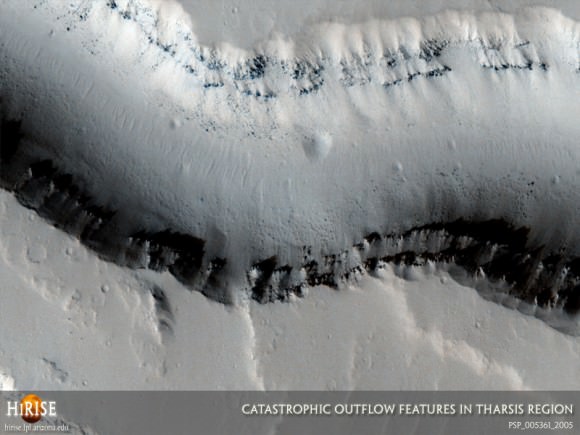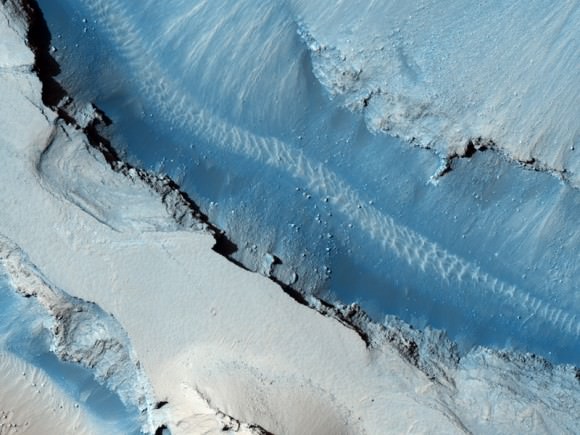Large features on Mars called outflow channels have been a point of contention among planetary scientists. “Most Mars scientists accept that outflow channels were carved by water, but alternate hypotheses persist, especially that lava carved the outflow channels,” said Alfred McEwen Principal Investigator of the HiRISE camera on the Mars Reconnaissance Orbiter. McEwen said that water is still the preferred mechanism and he doubts that all the channels could have been created by lava flows. But in what could be seen as a type of compromise, he offered a new theory for the outflow channels, based on observations by HiRISE: the channels were originally carved by huge water flows on ancient Mars and later were partially filled in by lava.
“This sequence of events provides a better explanation,” McEwen said.
Large outflow channels can be 10 km or more in width and may be hundreds of kilometers long. From orbital images, they appear to be huge, dry river beds, carved by very large volumes of running water.
While these features are too large to have been caused by flooding from rainfall, other explanations have been offered. One model involves large amounts of water frozen as permafrost in the soil and when a major source of local heating occurred, such as volcanic activity, there was melting and catastrophic flooding.
However, other explanations don’t involve water at all, but suggest flowing lava created these channels.
Speaking at the 2012 Lunar and Planetary Science Conference last week, McEwen mentioned specifically one proponent of the lava hypothesis, David Leverington from Texas Tech University, who proposed last year that slippery, low-viscosity lavas created the channels. Leverington says the lava hypothesis offers a simpler explanation that fits well within a wider geological framework of Mars and compares well with similar channel-like features on the Moon and Venus.
“He makes some good points,” McEwen said, “and argues for a form of Occam’s Razor. But we have been searching extensively with HiRISE and finding things that satisfy Leverington’s challenges.”
McEwen said the abundant evidence of water carving the channels is too hard to dismiss. Several examples of outflow channels show deposits from water-based flooding that lava flow can’t explain; additionally, there is ample evidence of bedrock erosion by water on Mars.
McEwen also said crater dating areas of several outflow channels show that the channels themselves are older than the lava flow.
“In the Athabasca Valles channels, MRO data showed that lava completely filled the channels and even overflow in places,” he said. “The lava can actually make channels look young.”
Uzboi Valles offers the best counterexample to Leverington’s hypothesis, McEwen said. “No lava fills in this highlands channel, and the channel preserves local layered alluvial deposits and shorelines. So that means we cannot explain all outflows channels from lava erosion.”
McEwen and his team suggest that large floods may have occurred in the Hesperian to early Amazonian, ending about 1 to 1.5 billion years ago, carving the channels. Then, later came the lava flows that formed Mars’ broad plains and sand dunes that we now see – which also filled in some of the outflow channels.
But McEwen said the debate about these channels is good science. “Did water create these channels? That is a good question,” he said. “We shouldn’t just assume the answer is yes. But we propose water must have carved at least some of the channels, and that water outflow is the main mechanism. If you disagree with anything I’ve said, go to theHiRISE website’s “HiWish” page to suggest areas for further imaging of these features. I’ve been disappointed how few members of the science community have used this tool,” he said.
Further reading:
Source: Universe Today



No hay comentarios:
Publicar un comentario